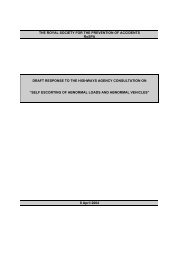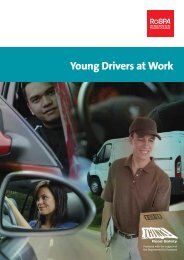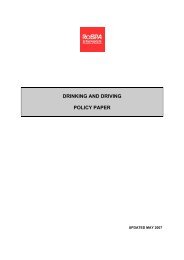Road safety policy and links to wider objectives - RoSPA
Road safety policy and links to wider objectives - RoSPA
Road safety policy and links to wider objectives - RoSPA
You also want an ePaper? Increase the reach of your titles
YUMPU automatically turns print PDFs into web optimized ePapers that Google loves.
55<br />
More recently cities such as Bris<strong>to</strong>l <strong>and</strong> Portsmouth have introduced 20mph limits without traffic calming. These can cover much<br />
larger areas because of the reduced expense in engineering the roads themselves. They have been effective at reducing traffic speeds,<br />
although less so than zones with traffic calming. 17 18 20mph limits can be more effective when coupled with other transport planning<br />
<strong>and</strong> road <strong>safety</strong> interventions.<br />
The <strong>wider</strong> adoption of 20mph zones or limits could reduce fatal traffic injuries further. The North West Public Health Observa<strong>to</strong>ry<br />
estimated that 20mph zones in the region’s residential areas between 2004 <strong>and</strong> 2008 would have prevented 140 fatal or serious injuries<br />
<strong>to</strong> children. This would have been a reduction of 26% on the actual figures. In addition, there would have been a 26% reduction in all<br />
pedestrian casualties <strong>and</strong> 14% reduction in all cyclist casualties. 19<br />
As well as vulnerable road users, the safe system can prevent fatal collisions <strong>to</strong> car occupants. There are several design st<strong>and</strong>ards in<br />
Vision Zero that are based on the idea of separating traffic, or integrating it at speeds that have a low risk of fatal injury:<br />
l Car occupants should not be exposed <strong>to</strong> other mo<strong>to</strong>rised vehicles at speeds exceeding 50km/h in 90° crossings – If this criteria<br />
cannot be satisfied then the traffic should be separated or the angle reduced<br />
l Car occupants should not be exposed <strong>to</strong> oncoming traffic at speeds exceeding 70km/h or 50km/h if oncoming vehicles are of<br />
considerably different weights – If this criteria cannot be satisfied then separate the traffic or homogenise weights<br />
l Car occupants should not be exposed <strong>to</strong> road sides at speeds exceeding 70km/h or 50km/h if the road side contains trees – If this<br />
criteria cannot be satisfied then traffic should be separated from the roadside 20<br />
Separation in Vision Zero is achieved by physical means, such as by using barriers or redesigning roads so that traffic is spatially<br />
separate (e.g., dual carriageways). Methods <strong>to</strong> separate traffic in time, such as traffic lights or pedestrian crossings, are not seen as<br />
measures that satisfy the criteria for higher speeds.<br />
Cable barriers are often used <strong>to</strong> separate the traffic on single carriageway national trunk roads in Sweden. These roads are 13m in width<br />
<strong>and</strong> a 2+1 lane layout is used, meaning that one direction of traffic has a single lane <strong>and</strong> the other direction has two, with the extra lane<br />
alternating between the directions. The barrier is continuous. An evaluation of these roads found there was a 76% reduction in fatalities<br />
when compared with the normal outcome for the previous road layout. 21<br />
Reducing traffic volume as a road <strong>safety</strong> intervention<br />
Traffic injury is a problem that is caused by travel. Travel is rarely an aim in itself but is caused by a dem<strong>and</strong> for activities such as<br />
employment, shopping, or socialising. Due <strong>to</strong> this, the amount of travel that a population does by different modes is influenced by<br />
urban planning, as this determines how accessible various activities are.<br />
For instance, the longst<strong>and</strong>ing <strong>policy</strong> of urban containment has prevented urban sprawl <strong>and</strong> meant that public transport networks<br />
are still possible within cities; it has also caused an increasing separation between homes <strong>and</strong> workplaces which led <strong>to</strong> more<br />
long-distance commuting. 22<br />
This increase in traffic has meant that the urban environment has been changed <strong>to</strong> accommodate it, 23 predominantly through building<br />
new roads. This created a cycle which leads <strong>to</strong> more car use <strong>and</strong> further changes <strong>to</strong> the urban environment. The result of this is an<br />
excessive reliance on cars as a form of transport.<br />
In the 1990s it became apparent that this cycle could not continue, as it was impossible <strong>to</strong> meet the forecasted traffic volumes,<br />
especially in urban areas. 24 Transport planning started <strong>to</strong> shift from a “predict <strong>and</strong> provide” model <strong>to</strong> a “predict <strong>and</strong> prevent” one.<br />
During the economic downturn that began in 2008, there was a reduction in the <strong>to</strong>tal amount of car use <strong>and</strong> a significant drop in the<br />
number of driver injuries in many western countries. Analysis of this drop identified there was a declining number of younger drivers.<br />
25 26 However, the overall growth in car use leading up <strong>to</strong> the economic downturn has potentially disguised the longer term downward<br />
trends in the number of younger drivers.<br />
Since the millennium there have been reductions in the amount of car travel by young drivers, particularly young males, in many of<br />
the major western economies. 27 This has been reflected in the decreasing percentage of young people who hold a driving licence, as<br />
shown in Figure 3. 28<br />
The mechanisms behind this decline in the number of licence holders are relatively unexplored, however, increasing youth<br />
unemployment, the use of other forms of travel, or the use of technology as a substitute for travel, seem <strong>to</strong> be likely explanations.<br />
Accident Prevention H<strong>and</strong>book Part 2: <strong>Road</strong> Safety Research

















